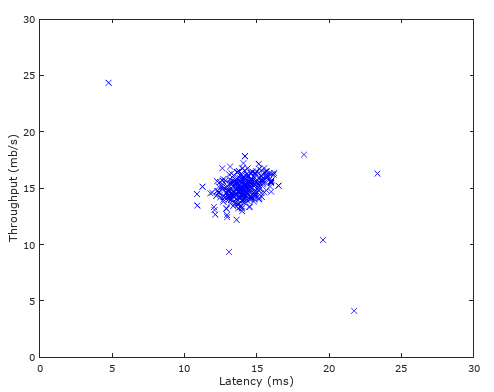在基于高斯分布的异常检测算法一文中,详细给出了异常检测算法的原理及其公式,本文为该算法的Octave仿真。实例为,根据训练样例(一组网络服务器)的吞吐量(Throughput)和延迟时间(Latency)数据,标记出异常的服务器。
可视化的数据集如下:

我们根据数据集X,计算其二维高斯分布的数学期望mu与方差sigma2:
function [mu sigma2] = estimateGaussian(X) %ESTIMATEGAUSSIAN This function estimates the parameters of a %Gaussian distribution using the data in X % [mu sigma2] = estimateGaussian(X), % The input X is the dataset with each n-dimensional data point in one row % The output is an n-dimensional vector mu, the mean of the data set % and the variances sigma^2, an n x 1 vector % % Useful variables [m, n] = size(X); mu = zeros(n, 1); sigma2 = zeros(n, 1); mu = sum(X,1)'/m; %note:mu and sigma are both n-demension. for(i=1:m) e=(X(i,:)'-mu); sigma2 += e.^2; endfor sigma2 = sigma2/m end
计算概率密度:
function p = multivariateGaussian(X, mu, Sigma2)
%MULTIVARIATEGAUSSIAN Computes the probability density function of the
%multivariate gaussian distribution.
% p = MULTIVARIATEGAUSSIAN(X, mu, Sigma2) Computes the probability
% density function of the examples X under the multivariate gaussian
% distribution with parameters mu and Sigma2. If Sigma2 is a matrix, it is
% treated as the covariance matrix. If Sigma2 is a vector, it is treated
% as the sigma^2 values of the variances in each dimension (a diagonal
% covariance matrix)
%
k = length(mu);
if (size(Sigma2, 2) == 1) || (size(Sigma2, 1) == 1)
Sigma2 = diag(Sigma2);
end
X = bsxfun(@minus, X, mu(:)');
p = (2 * pi) ^ (- k / 2) * det(Sigma2) ^ (-0.5) * ...
exp(-0.5 * sum(bsxfun(@times, X * pinv(Sigma2), X), 2));
end
可视化后:

根据预留的一部分已知是否异常的训练样例(CV集),来选择阈值:
function [bestEpsilon bestF1] = selectThreshold(yval, pval)
%SELECTTHRESHOLD Find the best threshold (epsilon) to use for selecting
%outliers
% [bestEpsilon bestF1] = SELECTTHRESHOLD(yval, pval) finds the best
% threshold to use for selecting outliers based on the results from a
% validation set (pval) and the ground truth (yval).
%
bestEpsilon = 0;
bestF1 = 0;
F1 = 0;
stepsize = (max(pval) - min(pval)) / 1000;
for epsilon = min(pval):stepsize:max(pval)
pred = (pval<epsilon);
p_e_1 = (pred==1);
y_e_1 = (yval==1);
p1 = 0;
m = size(p_e_1,1);
for(i=1:m)
if((p_e_1(i)==1)&&(p_e_1(i)==y_e_1(i)))
p1++;
endif
endfor
p_12 = sum(pred);
p_13 = sum(y_e_1);
p=p1/p_12;
r=p1/p_13;
F1 = 2*p*r/(p+r);
if F1 > bestF1
bestF1 = F1;
bestEpsilon = epsilon;
end
end
end
最终的标记结果:
